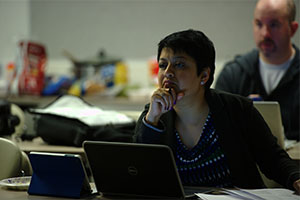February 3, 2016
SVSU ad expert Yelkur shares insights on 50 years of Super Bowl commercials
 EXTRA: Below, watch video of Rama Yelkur and SVSU students reflecting on Super Bowl commercial history. Also, click here to read about Yelkur's plans to analyze Super Bowl 50's advertisements using an SVSU focus group.
EXTRA: Below, watch video of Rama Yelkur and SVSU students reflecting on Super Bowl commercial history. Also, click here to read about Yelkur's plans to analyze Super Bowl 50's advertisements using an SVSU focus group.
Rama Yelkur, Saginaw Valley State University's dean of the College of Business and Management, has been one of the world's leading experts on Super Bowl advertising for pretty much all of the 21st century.
She has studied figures and charts and equations spanning 49 Super Bowls and the hundreds of marketing campaigns that have accompanied them. Her findings sometimes reveal complex data that points to even more complicated human behavior. Other times, it shows something she understood even before she became an expert on the subject of Super Bowl commercials: Watching people flee from a stampede of squirrels is hilarious.
“That one always sticks out in my head,” Yelkur said of the scene captured in Electronic Data System's “Running of the Squirrels” advertisement during the 2001 Super Bowl. “That really caught my attention because it took a worldwide event – the running of the bulls – and turned it into a memorable parody.”
The advertisement isn't often recognized among the iconic Super Bowl advertisements - the Mean Joe Greene appearance in a Coca-Cola 60-second spot in 1980 and the Orwellian Apple ad in 1984 are more likely to make that list, Yelkur admitted - but the squirrel-centric advertisement does represent a winning formula she has identified for many of the modern advertisements: humor and animals.
With Super Bowl 50 set for Sunday Feb. 7, Yelkur reflected on how that “winning formula” has changed for Super Bowl commercials over a half-century.
As was the case with the Super Bowl game itself, the coinciding advertisements in those early years weren't celebrated with nearly the same level of hype generated in 2016. That fact can be measured in dollars, Yelkur pointed out. For instance, CBS will sell 30-second advertising spots for $5 million during Super Bowl 50. In 1967, those same ads would have sold for $40,000, or about $280,000 when adjusting inflation to today's dollars.
“You didn't really see the advertising ramp up until the 1980s,” she said. “The 1974 Joe Namath and Farrah Fawcett ad for Noxzema created a lot of hype, but the 1980s were when Super Bowl advertising really took off.”
The success of the Mean Joe Greene and Apple advertisements helped solidify the Super Bowl broadcast as high-profile advertising space that decade. So did the fact companies realized women also were watching the game and began adjusting their marketing accordingly.
Before the 1980s, most Super Bowl advertisements marketed shaving cream, razors, motor oil and vehicles. In the 1980s, marketing for food, beverages and movies became more prevalent. Many of those same types of products remain Super Bowl ad pillars today.
Trendy products have risen and fallen in prevalence during the game's commercial breaks. For instance, in the late 1990s and early 2000s, many Internet-based companies threw their hat in the ring. During the 2000 Super Bowl, 11 dotcom companies bought advertising space – some before their businesses had generated a single dollar of revenue, Yelkur said. The dotcom bubble burst shortly after, and the majority of those Internet-based advertisers from 2000 no longer exist.
The creative approach to Super Bowl advertising also has changed over the decades, Yelkur said. Advertisements from the 1960s and '70s were longer than their modern counterparts, often featuring people discussing the product's benefits in great detail.
“Then the game got so hyped, and people didn't want to hear lectures during commercials anymore,” Yelkur said. “They just wanted to be entertained.”
In the 1980s, more celebrities began appearing in the marketing spots. Commercials featuring children also scored strongly with consumers around that time. By the 1990s, two new trends in Super Bowl advertising strategy emerged that remain a strong formula today: Animals and humor.
“Particularly, when they are paired together, we start to see animals and humor are huge drivers of advertisements,” Yelkur said. “Anheuser-Busch started using the Budweiser frogs, Dalmatians and Clydesdale horses. There was the E-Trade monkey and the Coca-Cola polar bears.”
Yelkur will gather with about a dozen SVSU students this Super Bowl Sunday – as she has since 2014 – to watch the game and its commercials. They will study the ads live and analyze the marketing campaigns' impact on consumers in the days following the game, looking for trends that could define future generations of Super Bowl advertising.
“It's fascinating,” Yelkur said of the way Super Bowl advertising has grown into its own institution. “In many ways, it dominates the scene for businesses. It's exciting to see what they bring, year after year.”
Along with her late research colleague Chuck Tomkovick, Yelkur's work has been published in leading scholarly journals and has been cited widely in popular media, including Advertising Age, CNN Money, The New York Times, USA Today, and The Wall Street Journal.
EXTRA: Click here to read about Yelkur's plans to analyze Super Bowl 50's advertisements using an SVSU focus group.
